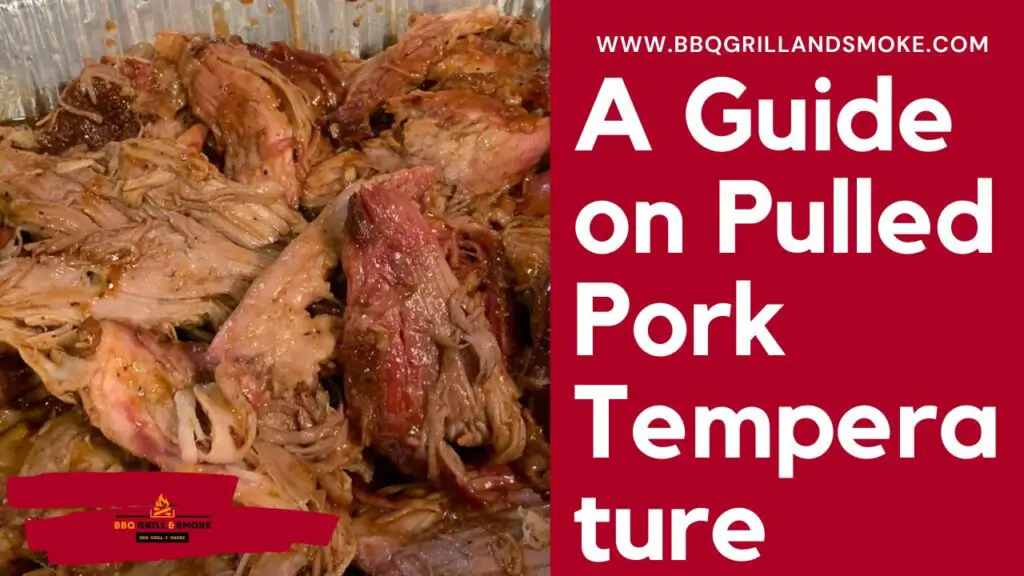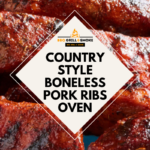If you are wondering about the best internal temperature for pulled pork, then this guide on “A guide on pulled pork temperature” is your best bet.
It is very important that you make sure that the meat has reached the correct internal temp for flavor-packed meat.
If not, you would just be left with tough meat that wouldn’t shred.
This guide will help you master the ideal temperature for pulled pork at your next BBQ, whether you are roasting, grilling, or smoking.

Pulled pork is just an excellent way to feed a crowd, given that the cooking process is more or less hands-off. In addition, pork is affordable and easy to work with.
For the perfect guide on pulled pork temperature, all you need to understand is how much pork you need per person, an in-oven meat thermometer, and a good dry rub recipe.
You definitely want to cook the meat low and slow if you want the best-pulled pork.
You will get a tough result that will be difficult to shred if you cook at higher temperatures.
Slow cooking at low temperatures will yield a tender, soft cut of meat that is ideal for shredding.
What Cut of Meat Is Best for Pulled Pork?
There are several different cuts of pork; however, it is also a fact that they can get really confusing in no time.
When it comes to the best cuts of meat for shredding, pork butt or pork shoulder are your best bet.
That being said, most times, the terms pork butt and pork shoulder are used interchangeably at grocery stores.
Although they are gotten from the same areas of the pig, there are slight differences:
Pork Butt
This cut, which is also commonly referred to as Boston butt, is gotten from the upper shoulder, and it is a fattier cut of meat, which makes it the perfect option for shredding.
Pork Shoulder
This cut, also commonly referred to as Picnic Shoulder, is slightly leaner and comes from only a part of the shoulder, which is from the front leg portion of the hog.
Keep in mind that other cuts, such as pork loin or pork roast, are not recommended for shredding.
The pork shoulder and butt cuts are packaged as large cuts of meat with a massive amount of fat.
Both options are great choices for pulled pork, whether you are roasting or smoking the meat to shred.
What’s the Best Internal Temperature for Pulled Pork?
For pork to be safe for consumption, the USDA recommends an internal temp of 145 degrees Fahrenheit.
However, when it comes to pulled pork, you need to go way beyond that.
Collagen begins to break down into gelatin at 160 degrees F, and the muscle fibers loosen. This process is what will make the meat succulent and easy to shred.
195 degrees F is actually the minimum internal temp recommended for pulled pork.
The internal temperature can rise up to 10 degrees during the resting period, which in turn makes the pork even more succulent.
Allow the pork to cook until the thermometer reads 202-205 degrees Fahrenheit to create the most incredibly easy-to-shred pork.
I strongly suggest against keeping it for longer, given that overcooking will only dry out the meat.
Navigating Temperature Across Different Cooking Techniques
Cooking pulled pork is not a versatile operation. Note that the technique you select can significantly affect the cooking temp and timeframe.
Mastering these variables is the key to achieving a succulent, tasty result.
Oven
The heat should be slightly higher, around 300 degrees Fahrenheit, if your preferred cooking technique is an oven.
This recreates the low-and-slow cooking style linked to traditional barbecue. It is roughly 40 minutes per pound of pork.
Smoker or Grill
Cooking pulled pork in a smoker or on a grill is your best bet if you are among people who enjoy the smoky undertones of grilled meats.
Just target to maintain a consistent temp of 225–250 degrees F, which permits the meat to cook slowly and get nice and smoky. It takes roughly 40 minutes per pound of pork.
Instant Pot
An Instant Pot is perfect for people short on time given that it can create succulent, shreddable pulled pork in remarkably less time.
Just set your Instant Pot to high and cook your pork for around 15 minutes per pound, but keep in mind that after the cooking process, allow an extra 10 minutes for natural pressure release.
Slow Cooker
For people looking for a hands-off approach, this technique is the perfect option.
Ensure that you set your slow cooker to high and cook for an hour for each pound of pork.
You can go for the low setting if you have more time, but this will require approximately two hours for each pound.
Note that, regardless of the method, the key is to reach the ideal internal temperature for pulled pork, which is 195 to 203 degrees Fahrenheit.
This helps make sure that your pork becomes tender enough to be pulled apart yet moist and flavorful.
In this journey, remember that your thermometer is your best friend, as it will help guide you towards the perfect temp to pull pork.
Tips for Smoking Great Pulled Pork
Below are tips for the most tender, finger-licking pulled pork you have ever tasted:
Trim It
It’s your call on how lean you want your pulled pork, so you can cut as much or as little fat off the shoulder as you like.
Rub It
Rub that shoulder down with the dry rub of your choice, immediately after you’ve trimmed it to your preference.
Coat it lavishly, as a lot of it will melt off the surface and season the meat inside, particularly if you don’t want to serve bland pulled pork.
I suggest you toss them into the fridge overnight if you have some time before you plan on cooking, then you can allow the rub to work its magic.
Just cover it and leave it out if you are more pressed for time, and then allow the shoulder to get as close to room temp as possible.
Prep the Smoker
Set your smoker to a low 250 degrees Fahrenheit, as you are now ready to cook.
You might have different settings, as this is based on your cooker. Just consult your manual if there’s any confusion.
There are people who believe that gas grills make the best pulled pork, and others who love the smoky taste imbued by the pellet variety or charcoal smokers.
However, I believe that if it is seasoned correctly and cooked to the correct temp, there’s nothing as bad as pulled pork.
Smoke It
Just place your shoulder on the grill and make sure the fat side is up.
Stick your meat thermometer, if you are using one, into the thickest part of the meat; that way, it does not fall out.
Rest It
Immediately after it has reached the best-pulled pork internal temperature, take it off the grill and wrap it in tin foil.
Before you start the shredding process, allow it to rest for at least thirty minutes.
Don’t rush; keep in mind that allowing it to rest is vital for letting all the juices return to the meat and giving you the best results.
At What Temperature Will Pulled Pork Stall?
When pulled pork reaches around 140 to 160 degrees F, it has reached what is referred to as the “stall,” or the slowdown.
The temp might not seem like it is rising anymore during this time, but I can assure you that it will eventually.
Just remain diligent and make sure your pork remains on the smoker until it reaches 185 degrees Fahrenheit.
Final Thoughts on Pulled Pork Temperature
It is true that this method can seem intimidating, but I strongly suggest you just trust the process.
Pulled pork is one of the easiest and most delicious dishes to prepare on your smoker.
You will master smoking pork shoulder in no time if you follow the guidelines here.
You now have everything you need to know about cooking pulled pork to perfection, all in this guide on “A guide on pulled pork temperature.”





